Tailieumoi.vn xin giới thiệu đến các quý Thầy/Cô Bài giảng điện tử Tiếng anh 8 Unit 7: Environmental protection sách Kết nối tri thức theo mẫu Giáo án POWERPOINT chuẩn của Bộ GD&ĐT. Hi vọng tài liệu này sẽ giúp Giáo viên dễ dàng biên soạn giáo án PPT Tiếng anh 8.
Chỉ 500k mua trọn bộ Giáo án Tiếng anh 8 Kết nối tri thức bản POWERPOINT trình bày đẹp mắt, thiết kế hiện đại (chỉ từ 30k cho 1 bài Giáo án lẻ bất kì):
B1: Gửi phí vào tài khoản0711000255837 - NGUYEN THANH TUYEN - Ngân hàng Vietcombank (QR)
B2: Nhắn tin tới zalo Vietjack Official - nhấn vào đây
Xem thử tài liệu tại đây: Link tài liệu
Bài giảng điện tử Tiếng anh 8 Unit 7: Environmental protection
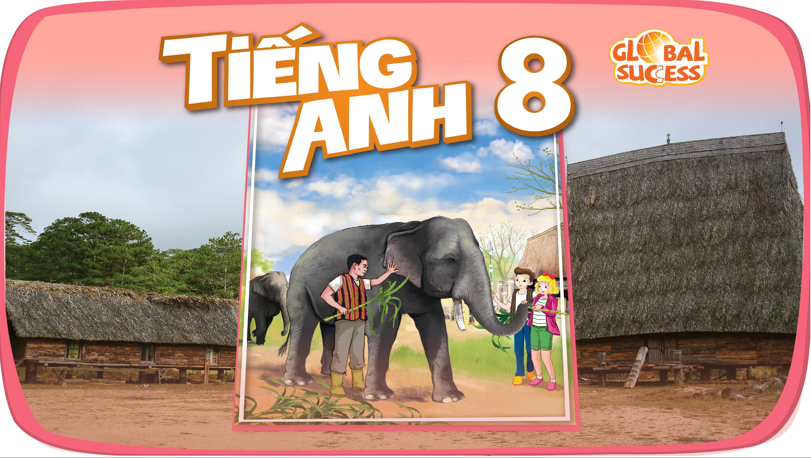
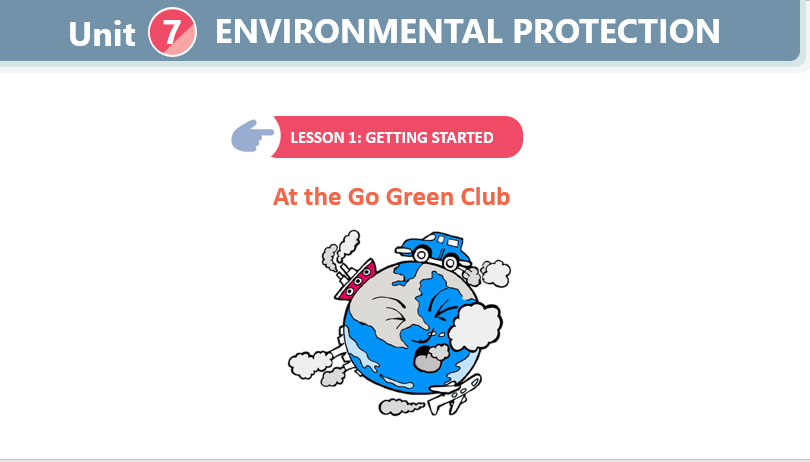
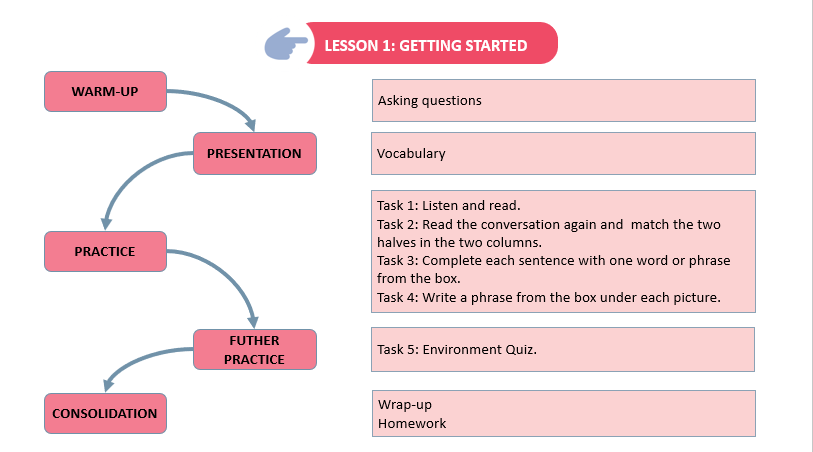
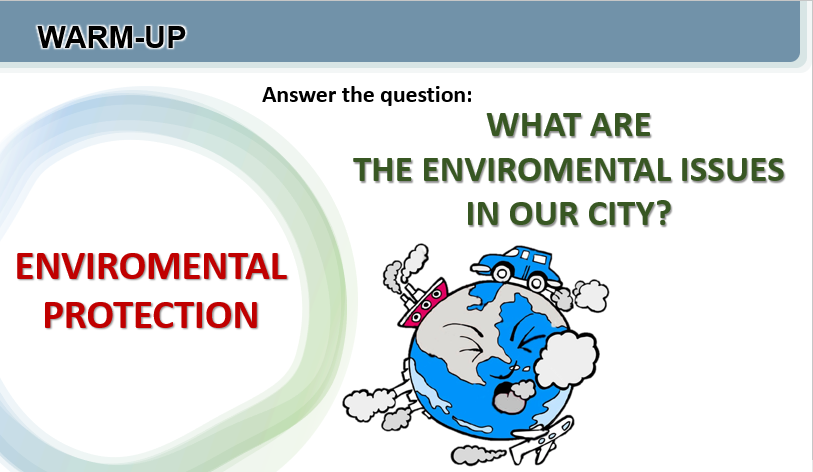
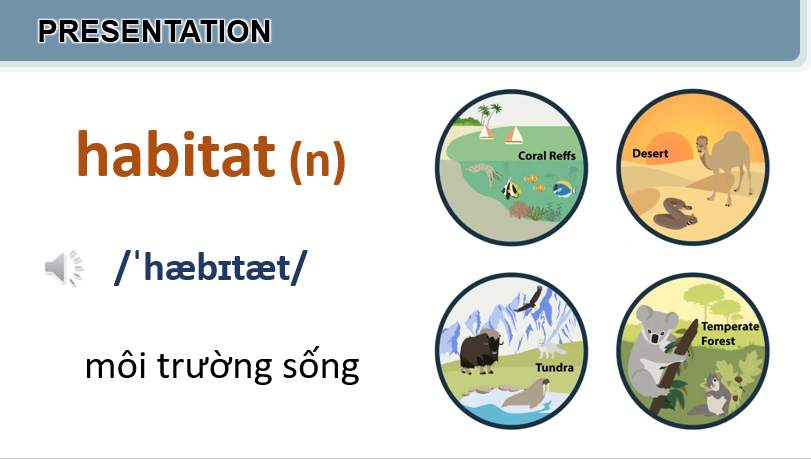
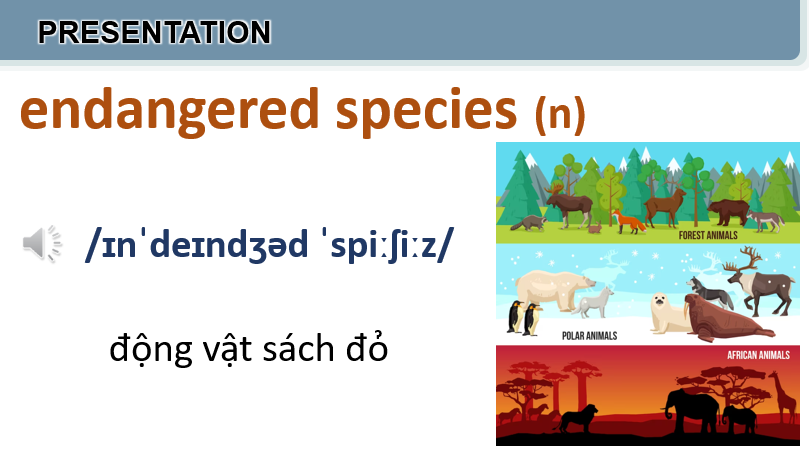
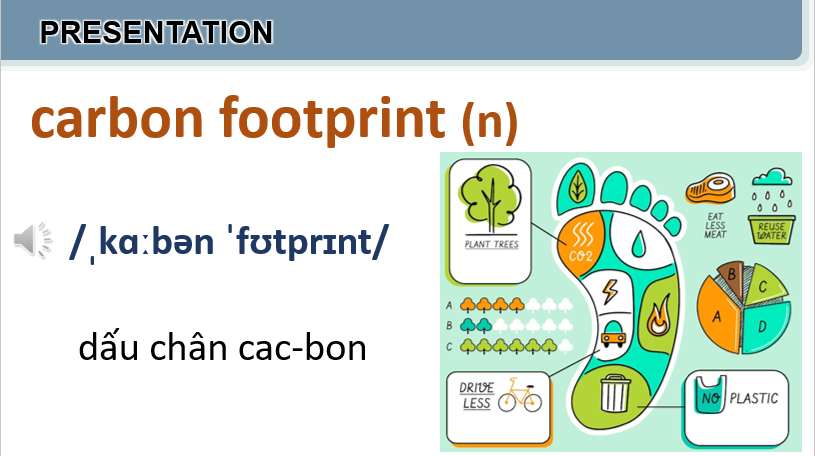
................................
................................
................................
Giáo án Tiếng Anh 8 Unit 7 (Global Success): Environmental protection
Lesson 1: Getting started – At the Go Green Club
I. OBJECTIVES
By the end of this lesson, Ss will be able to:
1. Knowledge
- Gain an overview about the topic Environmental protection
- Gain vocabulary to talk about Environmental protection
2. Competences
- Develop communication skills and creativity
- Be collaborative and supportive in pair work and teamwork
- Actively join in class activities
3. Personal qualities
- Love talking about their favourite shopping place
II. MATERIALS
- Grade 8 textbook, Unit 7, Getting started
- Computer connected to the Internet
- Projector / TV/
- Phần mềm tương tác hoclieu.vn
Language analysis
|
Form |
Pronunciation |
Meaning |
Vietnamese equivalent |
|
1. habitat (n) |
/ˈhabəˌtat/ |
the natural home or environment of an animal, plant, or other organism. |
môi trường sống |
|
2. endangered species (n) |
/inˌdānjərd ˈspēSHēz/ |
a species of animal or plant that is seriously at risk of extinction. |
động vật sách đỏ |
|
3. carbon footprint (n) |
/ˌkärbən ˈfo͝otprint/ |
a measure of the amount of carbon dioxide and other carbon compounds emitted due to the consumption of fossil fuels by a particular person, group, etc. |
dấu chân cacbon |
|
4. release (v) |
/rəˈlēs/ |
allow or enable to escape from confinement; set free |
thải ra |
|
5. single-use (adj) |
/ ˈsiNGɡ(ə)l /yo͞os/ / |
designed to be used once and then disposed of or destroyed. |
dùng một lần |
Assumption
|
Anticipated difficulties |
Solutions |
|
Ss may lack experience of group / team work. |
Encourage Ss to work in groups so that they can help one another. Give short, clear instructions, and help if necessary. |
III. PROCEDURES
1. WARM-UP (5 mins)
a. Objectives:
- To set the context for the introductory dialogue;
- To introduce the topic of the unit.
b. Content:
- Teacher asks students: “What are environnmental issues in our city?”
- Teacher calls 3-5 students to answer.
- Teacher shows some pictures of environmental issues in Hanoi and asks students to guess the topic of the unit/lesson.
c. Expected outcomes:
- Students know the topic of the unit and be ready for the conversation.
d. Organisation
|
TEACHER’S AND STUDENTS’ ACTIVITIES
|
CONTENTS |
|
Asking questions: - Teacher asks students: “What are environmental issues in our city?” - Teacher calls 3-5 students to answer. - Teacher shows some pictures of environmental issues in Hanoi and asks students to guess the topic of the unit/lesson. - T sets the context for the listening and reading text: Write the title on the board Environmental protection – At the Go Green Club |
Questions:
What are environmental issues in our city? Suggested answers: Environmental protection |
e. Assessment
- Teacher calls 3-5 students to answer.
2. ACTIVITY 1: PRESENTATION (11 mins)
a. Objectives:
- To prepare vocabulary for students to understand the conversation.
b. Content:
- Teacher shows pictures and asks students to find those in the conversation.
- Teacher checks students’ understanding with a matching game
c. Expected outcomes:
- Students know how to use the target vocabulary.
d. Organisation
|
TEACHER’S AND STUDENTS’ ACTIVITIES
|
CONTENTS |
|
Vocabulary pre-teaching - Teacher explains the meaning of the new vocabulary by pictures. - Teacher reveals that the words according to the pitures will appear in the reading text and asks students to open their textbook to find these words - Teacher introduces the vocabulary. - Teacher checks students’ understanding with a matching |
New words: 1. habitat (n) 2. endangered species (n) 3. carbon footprint (n) 4. release (v) 5. single-use (adj) |
e. Assessment
- Teacher checks students’ pronunciation and gives feedback.
- Matching game.
3. ACTIVITY 2: PRACTICE (22 mins)
a. Objectives:
- To help Ss use words and phrases related to enviromental protection.
- To help Ss further understand the text.
b. Content:
- Task 2,3, 4 in Student book
c. Expected outcomes:
- Students understand the conversation and know the vocabulary related to the topic.
d. Organisation
|
TEACHER’S AND STUDENTS’ ACTIVITIES
|
CONTENTS |
|
Task 1. Listen ad read (7 mins) |
|
|
- Have Ss individually read the conversation and listen to the recording twice If Ss find it difficult to pronounce some words, let them practice in pairs and teacher walks around the class to help and correct if needed. - Tell them to practice in pairs before praticing them in front of the class. |
Audio script – Track 41: Club leader: Hello. Welcome back. Today we’re discussing environmental problems and environmental protection. What are our serious environmental problems now? Nam: Pollution and habitat loss, I think. Ann: I agree. The air and water quality are getting worse and worse. Club leader: Any others? Ann: Yes, I can think of some like global warming, endangered species loss, … Nam: So what should we do to help protect our environment? Club leader: We can reduce our carbon footprint even in our homes. Ann: What do you mean by “carbon footprint”? Club leader: It’s the amount of carbon dioxide we release into the environment. Ann: I see. So we can do things like turning off devices when we’re not using them. Club leader: Right … And there is much more we can do, like practising the 3Rs. Nam: We can plant more trees in our neighbourhood too. Ann: And try to avoid using single-use products, like plastic bags, and stop littering. Club leader: Yeah. And we can volunteer at some local environment programmes to save endangered species. |
|
Task 2. Read the conversation again and match the two halves in the two columns (5 mins) |
|
|
- Have Ss individually read the conversation again and match the two halves in the two columns. If Ss find it difficult to do the task, ask them to read the conversation again and find the information in it. - Tell them to compare their answers in pairs before sharing them with the class. Ask them to give evidence to support their answers. - Check their answers and explain if necessary.
|
Suggested answers: 1. C 2. D 3. E 4. A 5. B
|
|
Task 3. Complete each sentence with one word or phrase from the box. (5 mins) |
|
|
- Teacher asks Ss to read the sentences and find the words and phrases from the box to fill in the gaps. - Have Ss share answers before discussing it as a class. Write the correct answers on the board. Then, call on some Ss to read the sentences - Check the answers as a class. |
Answer key: 1. pollution 2. reduce 3. single-use 4. carbon footprint 5. environment programme |
|
Task 4. Write a phrase from the box under each picture. (5 mins) |
|
|
- Have Ss work in pairs. Ask them to look at the pictures carefully and study the words and phrases. Then Ss write suitable words or phrases under the right pictures. - Have Ss read each word or phrase in chorus. Check and correct their pronunciation. - For more able Ss, let them make sentences with these words and phrases. - Teacher checks the answers as a class and gives feedback. |
Answer key: 1. 3Rs 2. water pollution 3. endangered species 4. plastic rubbish 5. single-use products |
e. Assessment
- Teacher corrects for students as a whole class.
4. ACTIVITY 3: PRODUCTION (6 mins)
a. Objectives:
- To help Ss revise and learn about some environmental problems and environmental protection
b. Content:
- Ss work individually or in pairs.
- Give Ss some time (2 - 3 minutes) to do the task.
Tell them to answer all the questions.
- Explain to the Ss if they don’t know the answers
c. Expected outcomes:
- Students’ conversations
d. Organisation
|
TEACHER’S AND STUDENTS’ ACTIVITIES
|
CONTENTS |
|
Task 5: Environment Quiz Do the following quiz. - Ss work individually or in pairs. - Give Ss some time (2 - 3 minutes) to do the task. Tell them to answer all the questions. - Explain to the Ss if they don’t know the answers 1. Which of the following is the greenest form of transport? A. Motorbike. B. Bus. C. Bicycle. 2. Which of the following is a renewable source? A. Coal. B. Oil. C. Wind. 3. What causes the most pollution? A. Factories. B. Animals. C. Hospitals. 4. The surroundings in which we live are our ______. A. habitat B. place C. environment 5. Which of these will reduce your carbon footprint? A. Cutting down a lot of trees. B. Recycling paper products. C. Leaving the TV on all night. |
Suggested outcome:
1. C 2. C 3. A 4. C 5. B |
e. Assessment
- Teacher gives corrections and feedbacks to students’ answers.
4. CONSOLIDATION
a. Wrap-up
- Ask one or two Ss to tell the class what they have learnt.
- Ask Ss to say aloud some words and phrases they remember from the lesson
b. Homework
- Students’ workbook
Board Plan
|
Date of teaching Unit 7: Enviromental protection Lesson 1: Getting started – At the Go Green Club *Warm-up
* Vocabulary 1. habitat (n) 2. endangered species (n) 3. carbon footprint (n) 4. release (v) 5. single-use (adj) Task 1: Listen ad read. Task 2: Read the conversation again and match the two halves in the two columns. Task 3: Complete each sentence with one word or phrase from the box. Task 4: Write a phrase from the box under each picture. Task 5: Environment Quiz.
*Homework |
..............................
..............................
..............................
Xem thêm các bài giảng điện tử Tiếng anh 8 Global success hay, chi tiết khác:
Unit 7: Environmental protection
Để mua Giáo án PPT Tiếng anh 8 Global success năm 2024 mới nhất, mời Thầy/Cô liên hệ Mua tài liệu hay, chọn lọc